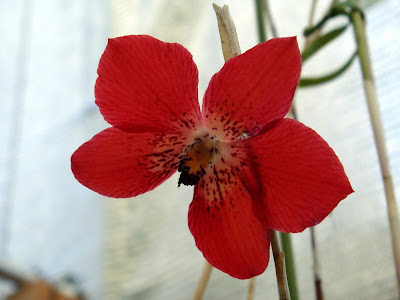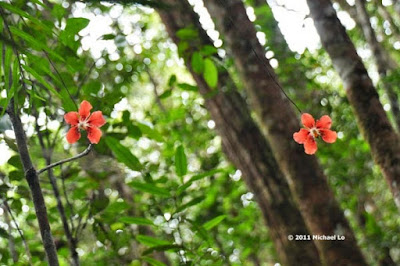Dendrobium cinnabarinum is native to Borneo. They were encountered in Labuan, Sabah (northern Borneo), and also in the Sarawak mountain forests near the limestone peaks north of Mt.Api (height 1200 m), in lower peat forests on Mt.Dulit (1,900 m high) and on Mt.Buda, on limestone (height 900-1000 m).
Dendrobium cinnabarinum, also called as The Vermillion Dendrobium, Aporum cinnabarinum, Ceraia cinnabarina, Ceraia sanguinea, Dendrobium cinnabarinum var. angustitepalum, Dendrobium holttumianum, Dendrobium sanguineum, is a species of the genus Dendrobium. This species was described by Heinrich Gustav Reichenbach in 1880.
IDENTIFY DENDROBIUM CINNABARINUM
Dendrobium cinnabarinum is native to Borneo. They were encountered in Labuan, Sabah (northern Borneo), and also in the Sarawak mountain forests near the limestone peaks north of Mt.Api (height 1200 m), in lower peat forests on Mt.Dulit (1,900 m high) and on Mt.Buda, on limestone (height 900-1000 m).
It is a medium sized, warm to cold growing epiphyte or lithophyte, which reaching 90 cm in height, with thin, 8 ridged towards the base, thicker above and then thinner towards the apex, shiny, 90 cm long stems carrying linear-oblong leaves.
The Vermillion Dendrobium blooms in the spring and fall on a 2" (5 cm) long, 1 to 3 flowered inflorescence arising from near the apex of leafless stems with short lived flowers. The flowers are 5-8 cm in diameter and are very variable in size, shape and color. Lancet-oval petals of the outer whorl and wider, ovoid petals of the inner whorl are crimson or cinnabar, and at the bases can be white or light ocher. A small lip, which may be whitish or pale orange, has a deep magenta, wavy top. The lip has spots, 3-5 purple lines and a yellow thickening. The front edge is strongly wavy.
DENDROBIUM CINNABARINUM CARE AND CULTURE
Cultural information should only be used as a guide, and should be to be adapted to suit you. Your physical location; where you grow your plants, how much time you have to devote to their care, and many other factors, will need to be taken into account. Only then can you decide on the cultural methods that best suit you and your plants.
Light:
Dendrobium cinnabarinum needs a light level of 20000 - 30000 lux.
Temperature:
Throughout the year the average daytime temperature is 23-24 ° C, at night 16-17 ° C, which gives a daily difference of 7-8 ° C.
Humidity:
The Vermillion Dendrobium needs a humidity of almost 80-85% throughout the year.
Substrate, growing media and repotting:
Dendrobium cinnabarinum can be mounted on pieces of tree ferns as long as you can provide high humidity and watering at least once a day during the summer. When planting them into pots, you can use any airy, fast-flowing substrate. Repotting can be performed in any period as soon as new roots grow.
Watering:
Water is abundant to very abundant throughout the year, with a slight reduction during the winter. Cultivated plants should be constantly moist, but not soaked.
Fertilizer:
It is recommend to use 1/4-1/2 doses of orchid fertilizer. The balanced fertilizer should be applied every week or every two weeks throughout the year.
Rest period:
In winter, the amount of water and fertilizers should be reduced, especially when cultivated in the conditions of a short, dark day at moderate latitudes. However, the Dendrobium cinnabarinum's substrate can not dry up completely.















COMMENTS